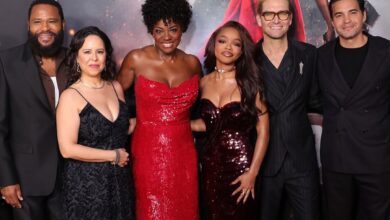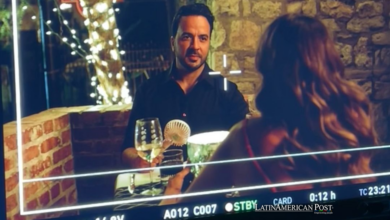Review of “Halloween Ends”: The Final End of the Saga?
One of the Longest-running and Most Successful Horror Sagas in Cinema Seems to Have Come to an End. This is Our Review of "Halloween Ends".

Photo: YT-Universal Pictures
LatinAmerican Post | Theoscar Mogollón González
Listen to this article
Leer en español: Reseña de “Halloween Ends”: ¿El final definitivo de la saga?
October has been characterized as the scariest month of the year thanks to Halloween, a tradition that is celebrated in various parts of the world with costume parties and other activities related to terror. The film industry has not been immune to these events and, since 1978, has paved the way for one of the most famous sagas of the slasher genre, which has 13 films after the recent premiere of "Halloween Ends". But will this be its final end?
The modern era of horror movies has given us several villains who, today, are a reference anywhere in the world. In a way, characters like Freddy Krueger and Jason Voorhees were inspired by Michael Myers, whose success in "Halloween" (1978) took the horror genre to a new level. However, despite the irregular way in which they have carried this saga over time, the fear and the expectation to see it on screen is still magnificent.
"Halloween Ends" closes the trilogy created by director David Gordon Green, which began with "Halloween" (2018) and continued with "Halloween Kills" (2021). On this occasion, the plot takes place four years after the previous film, with Laurie Strode living with her granddaughter Allyson and determined to live without fear or resentment after decades of terror. However, all those feelings will come back to her when an incident triggers a wave of violence that will bring Michael Myers back.
The film returns to the great performance of Jamie Lee Curtis in her original role of more than forty years. Alongside her are Andi Matichak, as Laurie's granddaughter; Will Patton, in the role of officer Frank Hawkins; and James Jude Courtney, behind the mask of the epic serial killer. As of the writing of this article, "Halloween Ends" has grossed twice its budget ($30 million) at the box office and it is estimated that it will break the $100 million barrier, something that only the first two installments of this triloy made.
An unconvincing film
Those who have followed the story of "Halloween" from its beginnings know that practically all the films present Michael Myers in the prologue murdering someone, a detail that became a kind of cliché of the saga. The detail with "Halloween Ends" is that this does not happen and, instead of the villain appearing, they decide to present a new character, who, although he will be part of the central axis of the story, ends up being diluted towards the end.
Corey is a teenager who has to work as a babysitter during Halloween night. After a small reference to the 1978 film and other typical scenes of the genre, the worst happens when the young man accidentally kills the boy who was in his care. Although he avoids going to jail, this event triggers a wave of hatred towards him from the townspeople, a similar situation that Laurie has been through, who ends up meeting him and introducing him to her granddaughter. From here the film takes an unexpected turn.
Gradually, the story begins to focus on Corey and Allyson, whose love relationship seems to last no more than ten minutes on screen. But not. The first half of "Halloween Ends" does not focus on showing us the real protagonists, nor on explaining what has happened with Michael Myers all this time or why he is connected to Laurie. In fact, the killer shows up at forty minutes and does so to start a strange bond with Corey.
Although the plot takes an unconvincing turn for many, it is worth mentioning that it is a well-constructed arc with moments of scares, cringe, blood and some laughs. Of course, all of this would have been great in some kind of spin-off, but since it is the "Halloween" saga, we all expect to see Michael Myers on the screen doing his thing and facing Laurie. Much of the film seeks to present the evil successors of the villain, although there are many detours that come to nothing.
The true essence of the saga, that for which the fanatic paid the entrance to the cinema, happens in the last minutes. That final showdown between Myers and Laurie is the high point of the Gordon Green trilogy and possibly the entire saga in general. We've learned over the past few decades that this villain can't be killed off so easily, but "Halloween Ends" proves that it can be, and it does so in a very emotional way. But will this be his true end? Will it have another reboot in a few years?
Also read: The True Crime Genre: Netflix's Lifesaver?
What is the chronology of "Halloween"?
The original "Halloween" timeline begins in 1978 with the John Carpenter film and extends with five other titles: "Halloween II" (1981), "Halloween III: Halloween" (1982), "Halloween 4: The Return of Michael Myers" (1988), "Halloween 5: The Revenge of Michael Myers" (1989), and "Halloween 6: The Curse of Michael Myers" (1995). Here we are given to understand that Myers was part of a satanic cult and that he has some kind of powers that explains why he never dies.
However, for the second timeline, the events that spanned from the third to the sixth film are denied, leaving only what happened in "Halloween" and "Halloween II". From here come "Halloween H20: Twenty Years Later" (1998) and "Halloween Resurrection" (2002). The novelty of this chronology is the return of the character of Jamie Lee Curtis and his subsequent suicide, in addition to the fact that Myers does not die as he did in the first timeline.
In turn, director Rob Zombie made a clean slate of the saga with his two films "Halloween" (2007) and "Halloween II" (2009). This time, the story shows the relationship between Myers and Laurie from another perspective. While it is a reboot of the original title, the second part has nothing to do with the 1981 film, although they share the same fateful fate for the villain.
Finally, Gordon Green's trilogy only takes reference from the 1978 film to develop "Halloween" (2018), "Halloween Kills" (2021) and Halloween Ends" (2022). The most notable thing about this line is part of a theme philosophical around Myers and about evil, because the more he kills and generates fear in people, the more force he absorbs.In the end, he makes us understand that evil is always inside people no matter how good they seem.




